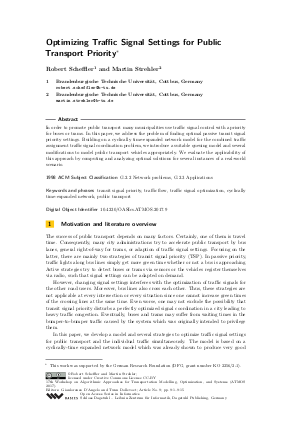Optimizing Traffic Signal Settings for Public Transport Priority
Authors Robert Scheffler, Martin Strehler
-
Part of:
Volume:
17th Workshop on Algorithmic Approaches for Transportation Modelling, Optimization, and Systems (ATMOS 2017)
Part of: Series: Open Access Series in Informatics (OASIcs)
Part of: Conference: Symposium on Algorithmic Approaches for Transportation Modelling, Optimization, and Systems (ATMOS) - License:
 Creative Commons Attribution 3.0 Unported license
Creative Commons Attribution 3.0 Unported license
- Publication Date: 2017-09-04
File

PDF
OASIcs.ATMOS.2017.9.pdf
- Filesize: 0.51 MB
- 15 pages
Document Identifiers
Subject Classification
Keywords
- transit signal priority
- traffic flow
- traffic signal optimization
- cyclically time-expanded network
- public transport
Metrics
- Access Statistics
-
Total Accesses (updated on a weekly basis)
0PDF Downloads0Metadata Views
Abstract
In order to promote public transport many municipalities use traffic signal control with a priority for buses or trams. In this paper, we address the problem of finding optimal passive transit signal priority settings. Building on a cyclically time-expanded network model for the combined traffic assignment traffic signal coordination problem, we introduce a suitable queuing model and several modifications to model public transport vehicles appropriately. We evaluate the applicability of this approach by computing and analyzing optimal solutions for several instances of a real-world scenario.
Cite As Get BibTex
Robert Scheffler and Martin Strehler. Optimizing Traffic Signal Settings for Public Transport Priority. In 17th Workshop on Algorithmic Approaches for Transportation Modelling, Optimization, and Systems (ATMOS 2017). Open Access Series in Informatics (OASIcs), Volume 59, pp. 9:1-9:15, Schloss Dagstuhl – Leibniz-Zentrum für Informatik (2017)
https://doi.org/10.4230/OASIcs.ATMOS.2017.9
BibTex
@InProceedings{scheffler_et_al:OASIcs.ATMOS.2017.9,
author = {Scheffler, Robert and Strehler, Martin},
title = {{Optimizing Traffic Signal Settings for Public Transport Priority}},
booktitle = {17th Workshop on Algorithmic Approaches for Transportation Modelling, Optimization, and Systems (ATMOS 2017)},
pages = {9:1--9:15},
series = {Open Access Series in Informatics (OASIcs)},
ISBN = {978-3-95977-042-2},
ISSN = {2190-6807},
year = {2017},
volume = {59},
editor = {D'Angelo, Gianlorenzo and Dollevoet, Twan},
publisher = {Schloss Dagstuhl -- Leibniz-Zentrum f{\"u}r Informatik},
address = {Dagstuhl, Germany},
URL = {https://drops.dagstuhl.de/entities/document/10.4230/OASIcs.ATMOS.2017.9},
URN = {urn:nbn:de:0030-drops-79005},
doi = {10.4230/OASIcs.ATMOS.2017.9},
annote = {Keywords: transit signal priority, traffic flow, traffic signal optimization, cyclically time-expanded network, public transport}
}
Author Details
References
-
Z. R. Abdy and B. R. Hellinga. Analytical method for estimating the impact of transit signal priority on vehicle delay. Journal of Transportation Engineering, 137(8):589-600, 2011.

- W. Brilon and W. Laubert. Priority for public transit in Germany. Journal of Advanced Transportation, 28(3):313-340, 1994. URL: http://dx.doi.org/10.1002/atr.5670280309.
-
L. R. Ford and D. R. Fulkerson. Flow in Networks. Princeton University Press, Princeton, 1962.

-
N. B. Hounsell and B. P. Shrestha. AVL based bus priority at traffic signals: A review of architectures and case study. European Journal of Transportation and Infrastructure Research, 5(1):13-29, 2005.

-
R. M. Karp. Reducibility Among Combinatorial Problems. In R. E. Miller and J. W. Thatcher, editors, Complexity of Computer Computations, pages 85-103. Plenum Press, New York, 1972.

- E. Köhler and M. Strehler. Traffic Signal Optimization Using Cyclically Expanded Networks. In 10th Workshop on Algorithmic Approaches for Transportation Modelling, Optimization, and Systems (ATMOS'10), volume 14 of OpenAccess Series in Informatics (OASIcs), pages 114-129, Dagstuhl, Germany, 2010. URL: http://dx.doi.org/10.4230/OASIcs.ATMOS.2010.114.
-
E. Köhler and M. Strehler. Combining static and dynamic models for traffic signal optimization - inherent load-dependent travel times in a cyclically time-expanded network model. Procedia - Social and Behavioral Sciences, 54(0):1125-1134, 2012.

- E. Köhler and M. Strehler. Traffic signal optimization using cyclically expanded networks. Networks, 65(3):244-261, 2015. URL: http://dx.doi.org/10.1002/net.21601.
-
P. Koonce, L. Rodegerdts, K. Lee, S. Quayle, S. Beaird, C. Braud, J. Bonneson, P. Tarnoff, and T. Urbanik. Traffic Signal Timing Manual. Report Number FHWA-HOP-08-024. Federal Highway Administration, 2008.

-
Y. Lin, X. Yang, N. Zou, and M. Franz. Transit signal priority control at signalized intersections: a comprehensive review. Transportation Letters, 7(3):168-180, 2015.

-
H. Liu, A. Skabardonis, and W. Zhang. A dynamic model for adaptive bus signal priority. In 82nd Transportation Research Board Annual Meeting, 2003.

-
H. Liu, J. Zhang, and D. Cheng. Analytical approach to evaluating transit signal priority. J. Transp. Syst. Eng. Inf. Technol., 8(2):48-57, 2008.

-
V. Ngan, T. Sayed, and A. Abdelfatah. Impacts of various parameters on transit signal priority effectiveness. J. Public Transp., 7(3):71-93, 2004.

-
R. Scheffler and M. Strehler. Optimizing Traffic Signal Timings for Mega Events. In M. Goerigk and R. Werneck, editors, 16th Workshop on Algorithmic Approaches for Transportation Modelling, Optimization, and Systems (ATMOS 2016), volume 54 of OpenAccess Series in Informatics (OASIcs), pages 8:1-8:16, Dagstuhl, Germany, 2016.

-
A. Skabardonis. Control strategies for transit priority. research report, University of California: California Partners for Advanced Transportation Technology, Berkely, 1998.

-
M. Strehler. Signalized Flows - optimizing traffic signals and guideposts and related network flow problems. Phd thesis, Brandenburgische Technische Universität, Cottbus, Germany, 2012.

-
S. R. Sunkari, P. S. Beasley, T. Urbanik, and D. B. Fambro. Model to evaluate the impacts of bus priority on signalized intersections. In Transportation Research Record 1494, pages 117-123, 1995.

-
J. Wahlstedt. Impact of bus priority in coordinated traffic signals. In Procedia Social and Behavioral Sciences, volume 16, pages 578-587. Elsevier, 2011.

-
G. Wünsch. Coordination of Traffic Signals in Networks. Phd thesis, Technische Universität Berlin, 2008.

